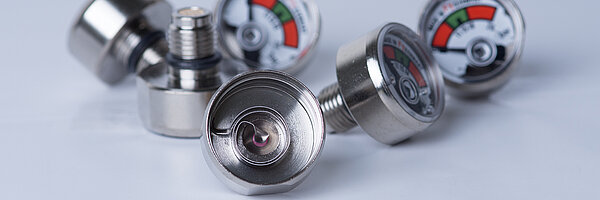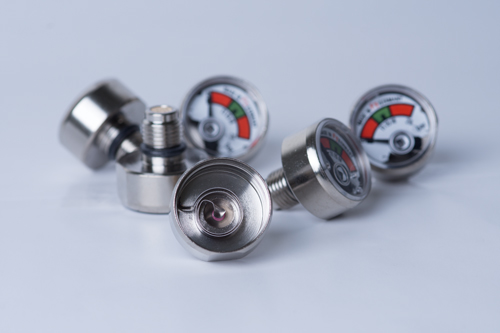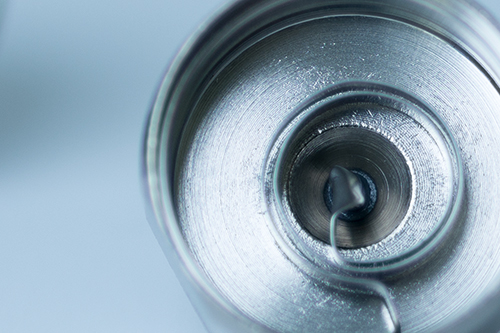Many fire extinguishers are equipped with pressure gauges, allowing users to check the pressure level in the container at any time. While soft soldering used to be the preferred method for manufacturing pressure gauges, it is now often replaced by bonding. The reason: a changeover from copper bronze to stainless steel.
FT Manovia, based in Buggingen near Freiburg, in the South of Germany, specializes in the manufacturing of pressure gauges for fire extinguishers, with an annual production of 5 million units. Founded in 1998, the company is the largest European manufacturer of fire extinguisher manometers and has a worldwide customer base. Manovia is certified according to ISO 9001:2015 and has its own production facility in Shanghai since 2005.
A key part of the production of pressure gauges, which indicate the pressure in the fire extinguisher on a scale, is connecting a spiral element made of copper bronze to a brass housing. These components used to be joined by soft soldering, but given that new fire extinguishing agents are aggressive to the copper/bronze compounds, a more robust material was required. Due to its inert properties, stainless steel was selected for the spiral elements. However, this made soft soldering an unsuitable method for joining the spiral element and the brass housing, and a new solution needed to be found, a method that was fast and space-saving.
Bonding Instead of Soldering
Purely mechanical processes such as cramping or shrink-fitting were too time-consuming or cost-intensive so that adhesive bonding became the method of choice for joining. As high demands are made on safety and resistance to aggressive chemicals, Manovia decided to use a heat-curing epoxy resins.
In its assembly line, Manovia could have applied the already known process of oven curing, where the adhesive cures during an oven cycle time of approx. 30 to 60 minutes. This would have required an oven of at least five meters in length and with a heat output of 45 kW in order to meet the target production capacity. Not only much space would have been needed, but also high purchase and energy costs would have been involved.
Induction Does It
In order to avoid such unprofitable and costly changeovers, faster curing processes were worked out in a process optimization workshop with DELO. Together both parties discussed different opportunities and induction curing turned out to be the best choice for Manovia, as it met all the requirements.
Induction curing is an efficient solution for metallic materials such as stainless steel. During inductive heating, the metallic component is exposed, either partially or completely, to an alternating electromagnetic field created by a current-carrying coil. This field generates eddy currents within the material, flowing opposite of the original current and heating the material. Induction therefore provides very fast heating of electrically conductive components and significantly reduces the heat-up time, thus accelerating the curing process. After further tests and a twelve-month field test, the process was enhanced in a way to allow optimal curing of the adhesive in only five seconds. The inductor, which Manovia adjusted to its specific needs, requires only little space compared to the continuous oven and consumes just two kilowatts of power.
It All Depends on the Right Adhesive
Since the adhesive is at least as important as the curing process, the company opted for DELO MONOPOX AD 295, a one-component, induction-suitable epoxy resin from DELO. The resin's very high chemical resistance was particularly convincing as the bonding has to withstand aggressive fire extinguishing agents. The structural adhesive has a good flow behavior and therefore good processing properties in the production process. It is also well suited for metal bonding and applications requiring both strength and reliability.
Conclusion
Adhesive curing by induction heating allows Manovia to produce their fire extinguisher pressure gauges fully automatically and cost-effectively. Researching on alternatives pays off: this was demonstrated by the Innovation Prize the German State of Baden-Württemberg awarded to FT Manovia.










